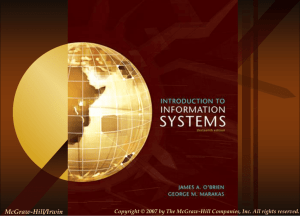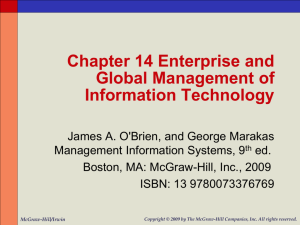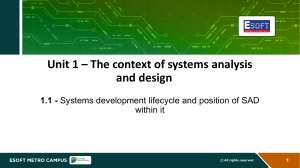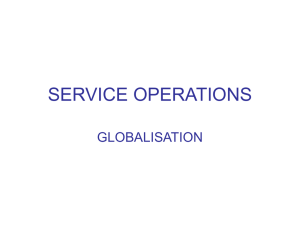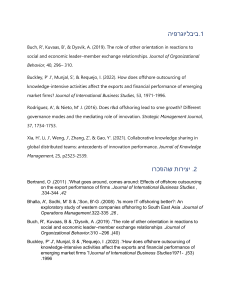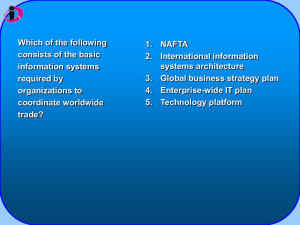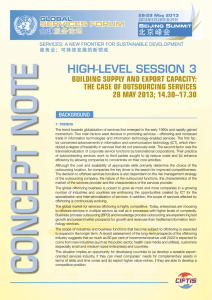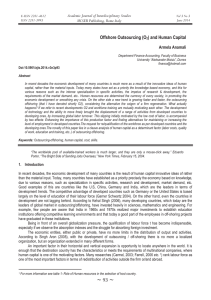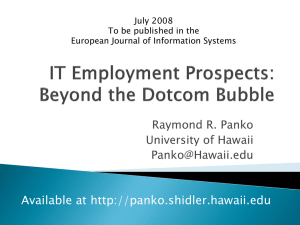Chap 14
advertisement
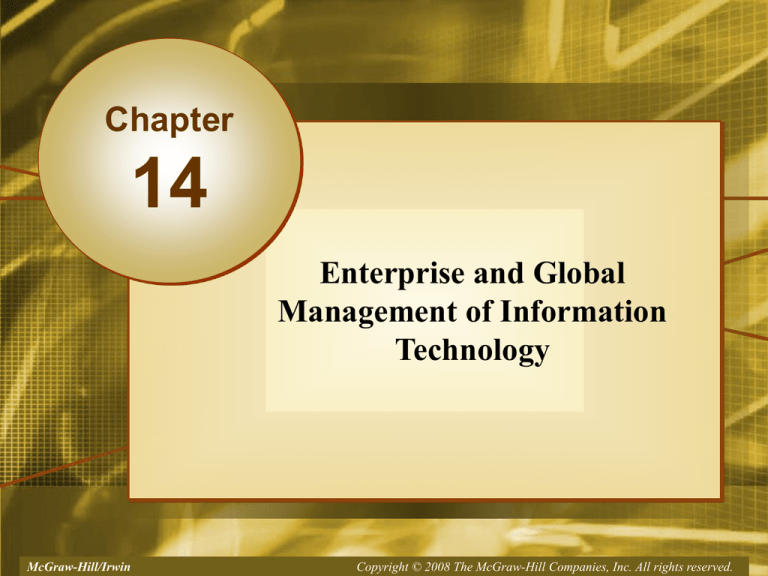
Chapter 14 Enterprise and Global Management of Information Technology McGraw-Hill/Irwin Copyright © 2008 2008,The TheMcGraw-Hill McGraw-HillCompanies, Companies,Inc. Inc.All Allrights rightsreserved. reserved. Learning Objectives • Identify each of the three components of information technology management • Use examples to illustrate how they might be implemented in a business • Explain how failures in IT management can be reduced by the involvement of business managers in IT planning and management 14-2 Learning Objectives • Identify several cultural, political, and geoeconomic challenges that confront managers in the management of global information technologies • Explain the effect on global business/IT strategy of the trend toward a transnational business strategy by international business organizations 14-3 Learning Objectives • Identify several considerations that affect the choice of IT applications, IT platforms, data access policies, and systems development methods by a global business enterprise • Understand the fundamental concepts of outsourcing and offshoring, as well as the primary reasons for selecting such an approach to IS/IT management 14-4 Business and IT • As the 21st century unfolds, many companies are transforming themselves into global powerhouses via major investments in • Global e-business • E-commerce • Other IT initiatives • There is a need for business managers and professionals to understand how to manage this vital organizational function 14-5 Components of IT Management 14-6 Managing Information Technology • Managing the joint development and implementation of business and IT strategies • Use IT to support strategic business priorities • Align IT with strategic business goals • Managing the development and implementation of new business/IT applications and technologies • Information systems development • Managing the IT organization and infrastructure • Hardware, software, databases, networks, and other resources 14-7 Comparing IT Management Approaches • Insert Figure 14.3 here 14-8 Managing the IT Function • Three things happened in the past few years • The Internet boom inspired businesses to connect their networks • Companies on on their intranets essential applications without which their businesses could not function • It became apparent that maintaining PCs on a network is very, very expensive • These things created an urgent need for centralization 14-9 Organizing IT • Early Years • Centralization of computing with large mainframes • Next • Downsizing and moving back to decentralization • Current • Centralized control over the management of IT while serving the strategic needs of business units • Hybrid of centralized and decentralized components 14-10 Avnet Marshall Organizational Components 14-11 Managing Application Development • Application development management involves • • • • • • Systems analysis and design Prototyping Applications programming Project management Quality assurance System maintenance 14-12 Managing IS Operations • IS operations management is concerned with the use of hardware, software, network, and personnel resources in data centers • Operational activities that must be managed • • • • Computer system operations Network management Production control Production support 14-13 System Performance Monitors • Software packages that • Monitor the processing of computer jobs • Help develop a planned schedule of computer operations that can optimize computer system performance • Product detailed statistics that are invaluable for effective planning and control of computing capacity 14-14 Features of System Performance Monitors • Chargeback Systems • Allocates costs to users based on the information service rendered • Process Control Capabilities • Systems that not only monitor but automatically control computer operations at large data centers 14-15 IT Staff Planning • Recruiting, training and retaining qualified IS personnel • Evaluating employee job performance and rewarding outstanding performance with salary increases and promotions • Setting salary and wage levels • Designing career paths 14-16 IT Executives • Chief Information Officer (CIO) • Oversees all uses of information technology in many companies, and brings them into alignment with strategic business goals • Chief Technology Officer (CTO) • In charge of all information technology planning and deployment • Manages the IT platform • Second in command 14-17 Other IT Positions • • • • E-commerce architect Technical team leader Practice manager Systems analyst 14-18 Technology Management • All information technologies must be managed as a technology platform for integrating business applications • Both internally or externally focused • The Internet, intranets, electronic commerce and collaboration technologies, CRM software, enterprise resource planning, and supply chain management • Often the primary responsibility of a chief technology officer 14-19 Managing User Services • Business units that support and manage end user and workgroup computing • Can be done with information centers staffed with user liaison specialists or with Web-enabled intranet help desks • Key roles • • • • Troubleshooting problems Gathering and communicating information Coordinating educational efforts Helping with end user application development 14-20 Outsourcing • The purchase of goods or services from third-party partners that were previously provided internally 14-21 Outsourcing’s Top Ten 14-22 Why Outsource? • Save money – achieve greater ROI • Focus on core competencies – organizations can focus on the business that they are in • Achieve flexible staffing levels • Gain access to global resources • Decrease time to market 14-23 Offshoring • Relocation of an organization’s business processes to a lower cost location • This location is typically overseas • Can be either production or service • Growth of services offshoring is linked to • Availability of large amounts of reliable and affordable communication infrastructure • Digitization of many services 14-24 Failures in IT Management • IT not used effectively • Computerizing traditional business processes instead of developing innovative e-business processes • IT not used efficiently • Poor response times • Frequent downtimes • Poorly managed application development 14-25 Management Involvement & Governance • Managerial and end user involvement • Key ingredient to high-quality information system performance • Involve business managers in IT management • Governance structures, such as steering committees 14-26 Sr. Management’s Involvement in IT 14-27 The International Dimension • Companies around the world are developing new models to operate competitively in a digital economy • These models are structured, yet agile, global, yet local • They concentrate on maximizing the risk adjusted return from both knowledge and technology assets 14-28 Global IT Management Dimensions 14-29 Global IT Management Challenges • Political challenges • Many countries regulate or prohibit the transfer of data across their national boundaries • Others severely restrict, tax, or prohibit imports of hardware and software • Some have local content laws that specify the portion of the value of a product that must be added in that country if it is to be sold there • Others require a business to spend part of the revenue they earn in a country in that nation’s economy 14-30 Global IT Management Challenges • Geoeconomic challenges • Physical distances are still a major problem • It may take too long to fly in specialists • It is difficult to communicate in real time across 24 time zones • Many countries do not have good telephone and telecommunications services • It may be hard to find skilled local workers • There can be great differences in the cost of living and labor costs between countries 14-31 Global IT Management Challenges • Cultural challenges • • • • • • Languages Cultural interests Religions Customs Political philosophies Global IT managers need cultural training before they are sent on assignment • Different work styles and business relationships 14-32 Transnational Strategies • Companies are moving toward a transnational strategy • Business depends heavily on information systems and Internet technologies to help integrate global business activities • Requires an integrated and cooperative worldwide IT platform 14-33 Transnational Business/IT Strategies 14-34 Global Business Drivers • Business requirements caused by the nature of the industry and its competitive or environmental forces • Examples of global drivers: • • • • • Customers Products Operations Resources Collaboration 14-35 Global IT Platforms • Hardware Difficulties • • • • • • High prices High tariffs Import restrictions Long lead times for government approvals Lack of local service or spare parts Lack of documentation tailored to local conditions 14-36 Global IT Platforms • Software Difficulties • Packages developed in Europe may be incompatible with American or Asian versions • The software publisher may refuse to supply markets that disregard software licensing and copyright agreements 14-37 International Data Communications Issues 14-38 The Internet as a Global IT Platform • The Internet • An interconnected matrix that reaches tens of millions of users in over 100 countries • Business environment is free of traditional boundaries and limits • Without incurring massive cost outlays for telecommunications, companies can • Expand markets • Reduce communications and distribution costs • Improve profit margins 14-39 Key Questions for Global Websites • Will you have to develop a new navigational logic to accommodate cultural preferences? • What content will you translate, and what content will you create from scratch to address regional competitors or products that differ from those in the U.S.? • Should your multilingual effort be an adjunct to your main site, or will you make it a separate site, perhaps with a country-specific domain? 14-40 Key Questions for Global Websites • What kinds of traditional and new media advertising will you have to do in each country to draw traffic to your site? • Will your site get so many hits that you’ll need to set up a server in a local country? • What are the legal ramifications of having your website targeted at a particular country, such as laws on competitive behavior, treatment of children, or privacy? 14-41 Internet Users by World Region 14-42 Global Data Access Issues • Transborder Data Flows may be viewed as violating • A nation’s sovereignty because it avoids customs duties and regulations • Laws protecting the local IT industry from competition • Laws protecting local jobs • Privacy legislation 14-43 U.S.-E.U. Data Privacy Requirements • Key data privacy provisions • Notice of purpose and use of data collected • Ability to opt out of third-party distribution of data • Access for consumers to their information • Adequate security, data integrity, and enforcement provisions 14-44 Internet Access in Restrictive Countries • The struggle between Internet censorship and openness at the national level revolves around • Controlling the conduits • Filtering the flows • Punishing the purveyors • Most of the world has decided that restricting Internet access is not a viable policy • Restricting access also hurts a country’s opportunities for economic growth and prosperity 14-45 Global Government Internet Restrictions • High Government Access Fees • Kazakhstan, Kyrgyzstan • Government Monitored Access • China, Iran, Saudi Arabia, Azerbaijan, Ubekistan • Government Filtered Access • Belarus, Cuba, Iraq, Tunisia, Sierra Leone, Tajikistan, Turkmenistan, Vietnam • No Public Access Allowed • Burma, Libya, North Korea 14-46 Global Systems Development • Key development issues • Conflicts over local versus global system requirements • Trying to agree on common system features • Disturbances caused by systems implementation and maintenance activities • Global standardization of data definitions 14-47 Systems Development Strategies • Key strategies for global systems development • Transform an application used by the home office or a subsidiary into a global application • Set up a multinational development team • Parallel development • Centers of excellence • Offshore development 14-48 Internet-Enabled IT Development 14-49
